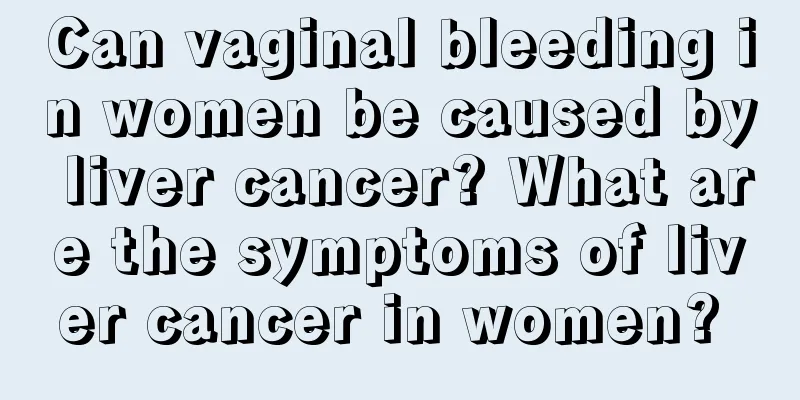Can vaginal bleeding in women be caused by liver cancer? What are the symptoms of liver cancer in women?

|
According to research, 98% of patients have hepatitis B. This shows that hepatitis B is an important cause of liver cancer. Therefore, as a country with a large number of hepatitis B cases, my country must be extremely careful about the problem of liver cancer. Only by discovering your physical condition in time and getting checked can you respond to liver cancer in time. Next, let's take a look at the early symptoms of liver cancer through a case. "It bleeds when I brush my teeth, and it bleeds when I rinse my mouth. It doesn't stop, and it takes more than an hour to stop. It's definitely not a simple gum disease." Mr. Zhang, a 58-year-old patient living in Fujian, has been troubled by bleeding gums for more than a month. He has lost his appetite. The slightest stimulation of the gums will cause a lot of bleeding. The patient and his family thought it was an oral disease, so they went to the hospital's oral department for a checkup. However, the checkup found that although the gums had some problems, they did not bleed continuously. The expert recommended that he undergo a detailed examination. After a blood test, it was found that the patient's platelet and white blood cell levels were very low, which showed that the problem of bleeding gums was not simple. Experts said that the bleeding did not stop because the platelet count was too low, only one-fourth of the normal level, which affected blood coagulation. Further investigation revealed that the patient had a large spleen, severe liver cirrhosis, and liver cancer that had entered the middle stage. "Basically, liver cancer caused problems with the immune system. The patient had suffered from hepatitis B and cirrhosis for many years, but had never paid attention to treatment, which caused the condition to worsen and led to cancer." So, what other early symptoms of cancer are there? (1) The patient has a history of hepatitis and cirrhosis, and his condition has been stable for many years without chills or fever, but suddenly develops dull or severe pain in the liver and gallbladder areas. (2) Adults over 30 years old may feel a lump in the right upper abdomen and epigastric region. The lump is hard and has an uneven surface. It shows a clear tendency to increase in size with continuous observation, but the patient does not feel any obvious discomfort. (3) Dry mouth, irritability, insomnia, gum and nasal bleeding, accompanied by upper abdominal distension and discomfort in the liver area. (4) Pain in joints throughout the body, especially in the lower back and back, accompanied by anorexia, irritability, and discomfort in the liver area, and poor response to anti-rheumatic treatment. (5) Patients with recurrent diarrhea accompanied by indigestion and abdominal distension, ineffective treatment for gastroenteritis or incurable disease, dull pain in the liver area, and gradual weight loss. (6) Persistent fever. Fever can occur in the early stages of liver cancer. When the body has persistent fever, the possibility of cancer should be highly suspected, and relevant medical examinations should be completed in a timely manner to make a clear diagnosis. (7) Fatigue and weight loss are common systemic symptoms, and are also accompanied by digestive tract symptoms such as indigestion, anorexia, nausea, and vomiting. Therefore, when the body has unexplained loss of appetite, a feeling of fullness immediately after eating, alternating diarrhea and constipation, and persistent indigestion, nausea, and hiccups, one should be vigilant and promptly undergo relevant early liver cancer examination methods to confirm the diagnosis. (8) Jaundice is also one of the common early symptoms of liver cancer. Therefore, when unexplained yellowing of the skin, sclera and other parts of the body occurs, one should be alert and promptly undergo relevant medical examinations to confirm the diagnosis. (9) Bloody stools, hematuria, and mucus in stools. When the body has unexplained hematuria, blood in the stool, or mucus in the stool, the possibility of liver cancer should be considered, and relevant medical examinations should be completed in a timely manner to ensure an early diagnosis. In addition to the above manifestations, the early symptoms of liver cancer are different between men and women. What are the symptoms of liver cancer in women? 1. Digestive tract symptoms Early symptoms of liver cancer in women include digestive tract symptoms, such as discomfort in the right upper abdomen, obvious indigestion, bloating, loss of appetite, etc. Once abdominal discomfort occurs, you should seek medical attention as soon as possible. 2. Liver symptoms The early symptoms of liver cancer in women are generally manifested as enlarged liver and spleen, obvious lumps, and unevenness. At the same time as these symptoms appear, there will also be dull pain in the liver area, which will gradually develop into severe pain. 3. Appearance of ascites and jaundice Common symptoms of female liver cancer patients include weight loss and swollen lymph nodes in the left clavicle, which are mainly caused by lymph node metastasis and are accompanied by cachexia. 4. Irregular vaginal bleeding In fact, the symptoms of women with this disease are irregular vaginal bleeding, which is because the female liver is damaged, resulting in a decrease in the coagulation mechanism, resulting in bleeding. The cause of this symptom may also be bleeding caused by liver cancer metastasizing to the female reproductive system. What are the common early symptoms of liver cancer in men? 1. Discomfort in the liver area: Early symptoms of liver cancer in men include dry mouth, irritability, insomnia, bleeding from gums and nose, accompanied by upper abdominal distension and discomfort in the liver area. 2. Lump: An early symptom of liver cancer in men over 30 years old. A lump can be felt in the right upper abdomen and upper abdomen. The lump is hard in texture, has an uneven surface, and shows an obvious tendency to increase with continuous observation, but the patient has no obvious discomfort. 3. Joint pain: Joint pain all over the body, especially in the waist and back, accompanied by anorexia, irritability, discomfort in the liver area, and poor response to anti-rheumatic treatment. This is also an early symptom of liver cancer in men. 4. History of hepatitis and cirrhosis: There is a history of hepatitis and cirrhosis, the condition has been stable for many years, there is no chills or fever, but sudden dull or severe pain in the liver and gallbladder areas. 5. Digestive system: Some early symptoms of liver cancer in men are repeated diarrhea accompanied by indigestion and abdominal distension. The treatment for gastroenteritis is not effective or cannot be cured. There is also dull pain in the liver area and gradual weight loss. 6. Ascites and jaundice: Hepatic ascites and jaundice occur. There are also symptoms of general fatigue, weight loss and cachexia; lymph node metastasis in the left clavicle can cause lymph node enlargement. How is liver cancer diagnosed? Symptom assessment: In addition to systemic symptoms such as unexplained weight loss and abnormal fatigue, patients with liver cancer may also experience clinical symptoms such as unexplained loss of appetite, nausea, vomiting, diarrhea, fever, and stuffy and painful sensation in the liver area. The first symptom of mid- to late-stage liver cancer is mainly pain in the liver area. Physical examination: In addition to the symptoms of enlarged and hard liver and spleen, there may also be blowing-like vascular murmurs in the liver area. Male liver cancer patients may also have signs such as breast tenderness, enlargement and breast lumps. X-ray examination: abdominal fluoroscopy or plain film shows enlarged liver shadow. Cancer in the right lobe of the liver often shows elevated right diaphragm, limited movement or localized bulge. X-ray barium meal examination shows compression of stomach and transverse colon in the left lobe of the liver or huge liver cancer. CT examination: It has high resolution and can detect early liver cancer with a diameter of about 1.0 cm. Enhanced scanning helps to distinguish it from hemangioma. The diagnostic coincidence rate for liver cancer is as high as 90%. But it is expensive. Therefore, it cannot be widely used. Ultrasound examination: B-type ultrasound examination can show the size and shape of the tumor, with a diagnostic accuracy rate of up to 84%. It can detect lesions with a diameter of 2 cm or less, and is currently a non-invasive examination method with good positioning value. This is also one of the diagnostic methods for liver cancer in life. Selective celiac artery or hepatic artery angiography: For cancers with rich blood vessels, it can sometimes show space-occupying lesions with a diameter of 0.5 to 1 cm, with a diagnostic accuracy rate of up to 90%. It can determine the location, size and distribution of the lesion, especially for the localization diagnosis of small liver cancer, which is the best among various examination methods currently available. |
<<: What should lung cancer diet be like? Specific principles of lung cancer diet revealed
>>: What are the symptoms of lung cancer? The most common symptoms of lung cancer
Recommend
Can I get pregnant after uterine cancer is cured?
The health of a woman's uterus is very import...
How to effectively treat cervical arteriosclerosis?
The treatment of cervical arteriosclerosis includ...
What are the downsides of eating too much?
Food is the basis of people's survival, and i...
Is white skin disease vitiligo?
Most white skin diseases are symptoms caused by v...
What are the dietary taboos for late-stage cervical cancer?
Is radiotherapy after cervical cancer surgery pai...
Can CT detect brain cancer?
Can CT scan detect brain cancer? 1. Brain tumors ...
What are the symptoms of hypokalemia
Hypokalemia is an internal medicine disease. Hypo...
Diagnosis of spleen rupture
There are several important parts in the human bo...
Is frequent stomach pain and acid reflux after meals due to gastritis?
In recent years, people's lives have graduall...
Insomnia, dry eyes, can't sleep
Insomnia is something that more and more people a...
Why does my stomach hurt?
This kind of pain is most often caused by the sto...
How to deal with feet scalded by boiling water?
Scalding your feet with boiling water is one of t...
Can wild crabs be eaten
There are many types of crabs, including sea crab...
Can fitness lower blood sugar?
Modern people pay more and more attention to phys...
What should be paid attention to when treating lung cancer? What should be paid attention to when treating lung cancer?
The occurrence of lung cancer is definitely a hug...









